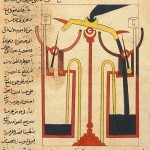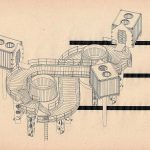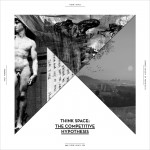The New Landscape in Art and Science is a 1956 book by György Kepes. The Hungarian-born artist, art theorist and educator taught along Laszlo Moholy-Nagy at the New Bauhaus school in Chicago and later was the founder of the Center for Advanced Visual Studies at the MIT. At the institute he was in contact with scientists from different domains and began working around the construction of a discourse which included both science and visual art in an attempt to find a common language between them. The connecting language in Kepes’ research turned out to be that of nature as further revealed by the new images accessible through the recent developments in science and technology.
Kepes “attempted to present in pictures the new visual world revealed by science and technology, things that were previously too big or too small, too opaque or too fast for the unaided eye to see.” (from Kepes: The New Landscape in Art and Science (1956) )
In 1951 he organized an exhibition titled “The New Landscape” presenting affinities among visual arts and recent visualizations of research models. Macro, computer images, photographs of the moon surface were shown along visual artists’ production in an attempt to let the similarities emerge. The focus is on recurrences of patterns, forms, growth and logical systems, rhythm.
In “The New Landscape in Art and Science” (1956), this research was translated into a publication.
 Transverse section of wood: 250X 1951 Photographic enlargement on particleboard Lent by Department of Special Collections, Stanford University Libraries
Transverse section of wood: 250X 1951 Photographic enlargement on particleboard Lent by Department of Special Collections, Stanford University Libraries
 Gyorgy Kepes Lichtenberg figures: A. R. von Hippel 1951 Photographic enlargement on particleboard Lent by Department of Special Collections, Stanford University Libraries
Gyorgy Kepes Lichtenberg figures: A. R. von Hippel 1951 Photographic enlargement on particleboard Lent by Department of Special Collections, Stanford University Libraries
 Transverse section of Osmanthus wood: 50X 1951 Photographic enlargement on particleboard Lent by Department of Special Collections, Stanford University Libraries
Transverse section of Osmanthus wood: 50X 1951 Photographic enlargement on particleboard Lent by Department of Special Collections, Stanford University Libraries
 Untitled Date unknown Photographic enlargement on particleboard, date unknown Lent by Department of Special Collections, Stanford University Libraries
Untitled Date unknown Photographic enlargement on particleboard, date unknown Lent by Department of Special Collections, Stanford University Libraries
 Gate, Photogenic 1948 Photographic enlargement on particleboard, date unknown Lent by Department of Special Collections, Stanford University Libraries
Gate, Photogenic 1948 Photographic enlargement on particleboard, date unknown Lent by Department of Special Collections, Stanford University Libraries
 Untitled Date unknown Photographic enlargement on particleboard, date unknown Lent by Department of Special Collections, Stanford University Libraries
Untitled Date unknown Photographic enlargement on particleboard, date unknown Lent by Department of Special Collections, Stanford University Libraries
 Lichtenberg figures: A. R. von Hippel 1951 Photographic enlargement on particleboard Lent by Department of Special Collections, Stanford University Libraries
Lichtenberg figures: A. R. von Hippel 1951 Photographic enlargement on particleboard Lent by Department of Special Collections, Stanford University Libraries
The obvious world that we know on gross levels of sight, sound taste and touch, can be connected with the subtle world revealed by our scientific instruments and devices. Seen together, aerial maps of river estuaries and road systems, feathers, fern leaves, branching blood vessels, nerve ganglia, electron micrographs of crystals and the tree-like patterns of electrical discharge-figures are connected, although they are vastly different in place, origin and scale … Their similarity of form is by no means accidental. As patterns of energy-gathering and energy-distribution, they are similar graphs generated by similar processes. György Kepes
Further reading:
Images via :





Leave a Reply